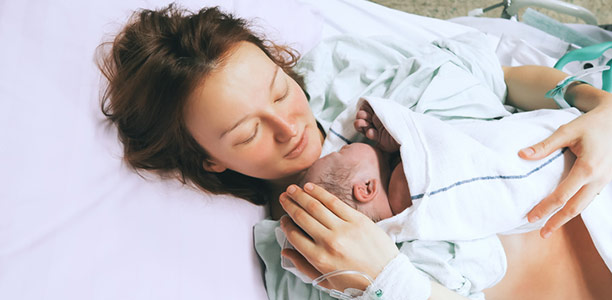For the first time, a team of leading international researchers have found significant links between medical interventions used in the birthing process, such as caesarean section and induction, and a child’s long-term health.
The findings, published in the Wiley journal Birth, include:
- Infants who experienced an instrumental birth following induction or augmentation had the highest risk of jaundice and feeding problems.
- Infants born by caesarean section had higher rates of hypothermia following birth.
- Children born by emergency caesarean section had the highest rates of metabolic disorders in later years.
- Odds of respiratory infections, metabolic disorder and eczema were highest amongst children who experienced any form of birth intervention.
Researchers from the University Medical Center Groningen and VU Medical Center (Amsterdam), Western Sydney University, Flinders University, University of Central Lancaster University (England), Sydney University and the University College Cork (Ireland) collaborated on the landmark study.
They analysed linked population and health data* pertaining to 491,590 healthy women and their children born in New South Wales from 2000-2008. The children’s health was then followed during their first 28 days of life, and up to 5 years of age, until 2013.
Professor Hannah Dahlen, from Western Sydney University’s School of Nursing and Midwifery, says the aim of the study was to examine the association between operative (for example caesarean section) and medical (induction or augmentation of labour) birth interventions on a child’s health in the first 28 days and first five years after birth.
“Across the board, the results indicate that the odds of a child developing a short or longer term health problem significantly increase if there was a medical intervention at the time of their birth,” says Professor Dahlen.
“The study adds to the mounting scientific evidence which suggests that children born by spontaneous vaginal birth, without commonly used medical and surgical intervention, have fewer health problems.”
Flinders University College of Nursing and Health Sciences researcher, Associate Professor Charlene Thornton, says the data showed some important trends for health care in the future.
“This is innovative and pioneering work into an examination of birth interventions within a healthy cohort,” Associate Professor Thornton says.
“We wanted to examine the associations between short and long-term health outcomes for the baby and the type of labour and birth process their mothers experience,” she says.
“In terms of short-term outcomes, babies who were born with the use of instruments following an induction of labour were almost three times more likely to develop jaundice than babies born following a spontaneous labour and a normal vaginal birth.
“For long-term health outcomes (up to 5 years of age), babies born via caesarean section regardless of whether their mothers experience labour or not, were more than twice as likely to be diagnosed with a metabolic disorder, such as diabetes and/or obesity.”
Dr Lillian Peters, a postdoc researcher also affiliated with the Midwifery Academy Amsterdam Groningen, says the study has demonstrated that children born by caesarean section are more susceptible to a range of adverse health outcomes.
“What we have done in this study – which is unique – is look at the use of hormones to start and stimulate labour as well as mode of birth,” Dr Peters says.
“With our international team, we will conduct future research to, hopefully, confirm or our findings by including other population-based data registries including a longer follow-up period for a wider range of adverse child health outcomes, particularly those that are found more commonly beyond 5 years of age.”
As part of the world-first study, NSW birth records were used to select a sample of ‘healthy’ mothers, without any pre-existing or pregnancy-related health conditions.
Women were only included in the study if they did not smoke or take drugs; were within the age range of 20-35 years, and gave birth at 37-41 weeks of gestation to a single baby within a normal weight range.
After applying all exclusion criteria, the final study cohort consisted of 491,590 low-risk pregnant women. The majority were Australian born (69%) and had a mean age of 29 years. Fifty-five percent of the women were having their first child.
A wide range of births were analysed:
- 88 per cent of women received pain medication during labour;
- 43 per cent were induced prior to labour, or received augmentation during labour;
- 38 per cent had a spontaneous vaginal birth, without medical intervention;
- 11 per cent had an elective caesarean section;
- 7 per cent had an emergency caesarean section after an induction or augmentation.
The latest research adds to development of the Epigenetic Impact in Childbirth hypothesis which proposes that vaginal birth provides an important opportunity to seed a healthy microbiome and the stress of normal physiological labour provides an important influence on epigenetic modulation.
“There is a general understanding that medical interventions may interrupt the normal stress of being born and seeding of a healthy microbiome and this can lead to a wide range of diverse health outcomes,” says Professor Dahlen.
“Too little stress (i.e. no labour and caesarean section) and too much stress (induced/augmented labour and instrumental birth) can both have a negative impact.”
By improving continuous support – or continuity of midwifery care – and introducing a more evidence-based approach to care in labour, the rates of physiological birth can improve and health outcomes will improve for all, she says.
“It is important that women and their partners have all the information about both short and long-term effects of intervention in order to make truly informed decisions about care,” she says.
(Source: Flinders University, Birth)










